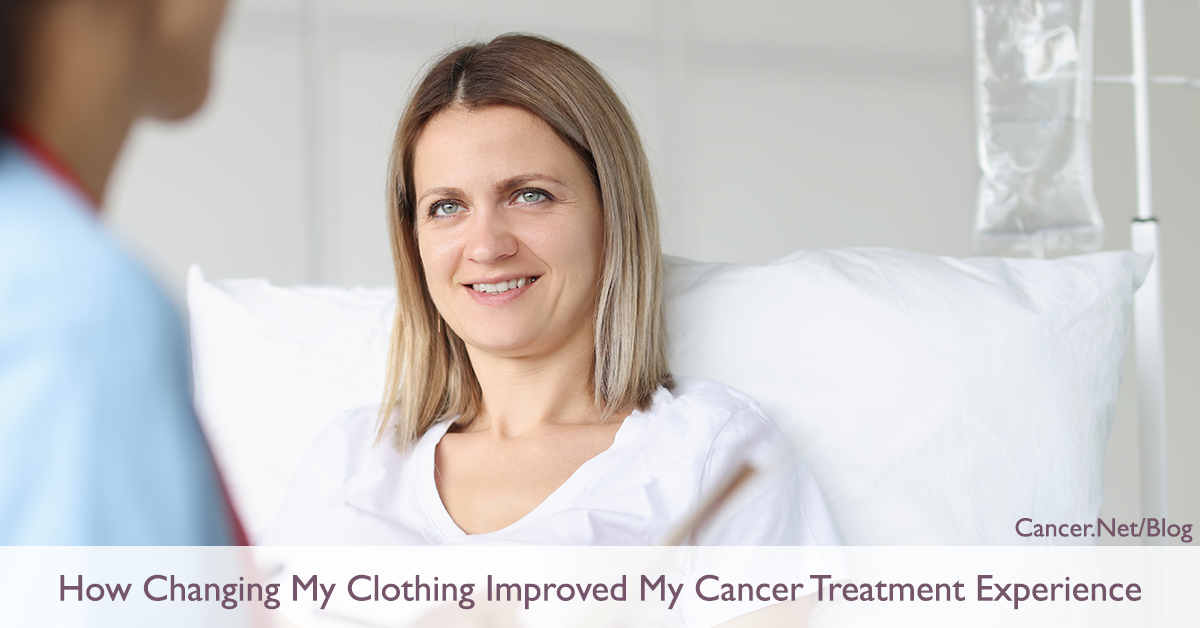
Voices on Cancer is an award-winning Cancer.Net Blog series where advocates share their stories and the lessons they have learned about being a cancer advocate. Cindy Trice is a cervical cancer survivor, veterinarian, and co-founder of KickIt Pajamas, a women-owned small business that designs apparel inspired from personal cancer experience with 1 goal in mind: to provide dignity, style, and comfort to people with cancer and ease of medical access for their caregivers and nurses. You can follow Cindy on Instagram and Facebook.
My advocacy story
In 2004, I was diagnosed with cervical cancer. After my diagnosis, I started receiving chemotherapy and radiation therapy, and I endured multiple hospitalizations. Going through cancer treatment was a difficult time in my life, as it is for many people with cancer. It was hard to be positive and feel comfortable in my own skin. It felt like my body had turned on me. While everyone told me that I needed to “stay positive,” it was hard to do so as I felt vulnerable, both emotionally and physically.
During cancer treatment, I found it especially challenging to stay positive while wearing a gown that left my entire backside exposed, irritated my already sensitive skin, and felt flimsy and unsupportive. It wasn’t until I was gifted a pair of pajamas by a dear childhood friend and wore them in the hospital that I felt much better. I was more comfortable, more positive, and ready for visitors and walks around the nurse’s station.
Throughout my cancer experience, I was lucky to have a healthy support group of family and friends as I navigated diagnosis, treatment, and survivorship. Everyone wanted to know what they could do to help. They stepped up in all sorts of ways: hospital visits, rides, meals, gifts, cards, or even just being a shoulder to cry on. It was through their support that I realized there was a great opportunity to help people with cancer by providing their loved ones the option to give the gifts of comfort and dignity.
How clothing can make a difference during cancer treatment
While undergoing treatments, recovering at home, receiving visitors, or interacting with medical teams, I learned that wearing clothing and accessories that provided comfort, style, and functionality really made a difference in my dignity and emotional well-being. Initially, it was difficult to understand why a simple article of clothing could have such a profound impact on my well-being. But after a bit of research, it seemed like the impact of hospital clothing on patients’ well-being has been widely overlooked, despite the known impact of clothing on social identity and self-expression.
Feeling unkempt or uncomfortable in clothing that isn’t suited to a body with surgical incisions, swollen arms or legs, distended abdomens, drains, or catheters and ports adds unnecessary discomfort and stress. Yet despite the financial, emotional, physical, and every other possible toll that people with cancer face, it felt like their needs were being left out of the equation when it came to medical clothing.
The more I researched, the more I discovered how hospital gowns are not designed for today’s medical necessities, let alone the needs of people with cancer. In fact, the current backless style of hospital gowns dates back to 1910 and was designed with 1 clear function in mind: to make it easier to use bedpans. Today, I’ve seen how these gowns continue to leave people with cancer feeling exposed, self-conscious, vulnerable, uncomfortable, cold, embarrassed, and disempowered.
When I would wear a gown during treatment, I couldn’t shake the memory of Jack Nicholson bare-bottomed in the movie Something’s Gotta Give, and the feeling that patients are sometimes made to be the “butt of the joke.” We’re suffering through already trying times that can seem even worse when wearing what can feel more like a dehumanizing uniform than a tool to help us heal.
Making it my mission to improve clothing during cancer
Living through cancer shifted my priorities. I was diagnosed just 2 months after graduating from veterinary school. Becoming a veterinarian was a career change for me so I could more closely align my desire to serve animals with my work. But as one of the lucky ones who survived cancer, I found a new life mission: to drive change in the cancer apparel industry. Almost 16 years past my “cancerversary,” I co-founded a women-owned business called KickIt Pajamas to provide dignity, style, and comfort to people with cancer and ease of medical access for their caregivers and nurses.
I’ve always wanted to be an entrepreneur, and cancer helped me identify a problem to solve and another group of people to serve. After all, there is no better way to understand how to solve a problem than while tackling it yourself. I’ve learned that if you can’t find the right solution, you can be sure there are others who can’t either. During cancer, I also realized that no one is guaranteed a long life span, and if I wanted something badly enough, I needed to switch from thinking, “One day I’ll pursue my dreams,” to being brave, taking action, and enjoying the journey.
For people with cancer and survivors interested in finding ways to help others with the disease, start by thinking of unique ways you can solve problems you’ve experienced during cancer. Don’t be afraid to network with people! Also, remember that taking care of yourself and your mental health is more important now than ever before, and there are plenty of resources available to help. Cancer.Net, for example, offers resources on managing stress, including tips for reducing stress and helpful relaxation techniques.
I know from personal experience the boost in psychological wellness I experienced when I felt well-dressed during cancer treatment. I realized I could be sick and pretty, vulnerable and fierce, and scared and brave, all at the same time. Today, I advocate for patient-inspired apparel to help people with cancer feel good and look better, allowing people with cancer to be more prepared, confident, and ready to take on cancer!
The author has no relevant relationships to disclose.







